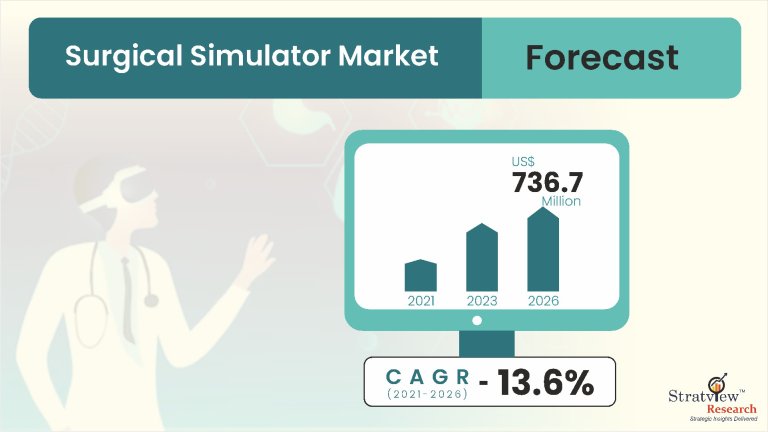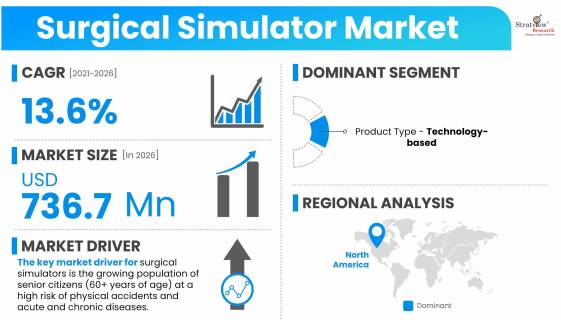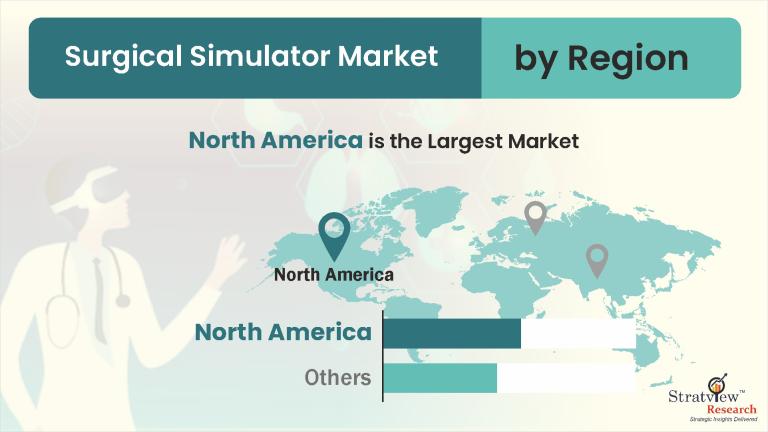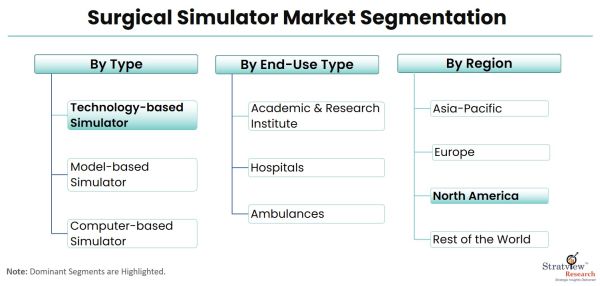Market Insights
The surgical simulator market was estimated at USD 332.7 million in 2021 and is likely to grow at a CAGR of 13.6% during 2021-2026 to reach USD 736.7 million in 2026.

Would you like to get a free sample? Register Here
Market Dynamics
Introduction
A surgical simulator is a device or software program that is designed to replicate surgical procedures, environments, and conditions for the purpose of training surgeons and other medical professionals. Surgical simulators can range from basic physical models, such as mannequins, to complex virtual reality systems that provide a realistic, immersive experience.
Surgical simulators are used to provide medical professionals with hands-on experience in a safe, controlled environment. They allow trainees to practice procedures and develop the skills necessary to perform surgeries without the risk of harm to living patients. Simulators can also be used to evaluate and improve the skills of experienced surgeons.
Market Drivers
- Infection Prevention through Simulation- Demand for surgical simulation is growing as hospitals and medical training centers are trying to reduce surgical errors and improve infection control. Simulation-based education can offer surgeons the ability to advance their accuracy when completing surgical procedures and decrease complications. According to The National Library of Medicine, surgical site infections (SSIs) account for ~20% of all Healthcare-Associated Infections (HAIs) in hospitalized patients. And surgical simulators can prevent up to 60% of SSIs effectively.
- Patient Safety Initiatives- The increasing focus on patient safety and prevention of medical errors is further necessitating the demand for surgical simulators. Researchers at Johns Hopkins Medicine found that medical errors are contributing >250,000 deaths per year in the United States, making it the third leading cause of death. The World Health Organization (WHO) and the Agency for Healthcare Research and Quality (AHRQ) both support the perception of simulation as an important element of improving patient outcomes and reducing surgical complications. For risk-free training, the demand for surgical simulators is expected to rise significantly.
- Growing Demand for Robotic-Assisted Surgery- The increasing acceptance of robotic assisted surgeries has driven demand for surgical simulators. The da Vinci Surgical System, one of the most common robotic platforms has been used to conduct over 14 million cases globally till 2023. With greater precision, fewer complications and faster recovery, robotic-assisted surgeries will drive more hospitals and surgical centers to develop robotic training simulators to help surgeons practice the needed skills and further drive the surgical simulators market globally.
Market Challenges:
- Regulatory and Ethical Barriers- Regulatory bodies like the US Food and Drug Administration (FDA) and European Medicines Agency (EMA) generally require extensive validation and compliance with laws on the protection of health data (such as HIPAA and GDPR) before the widespread deployment of AI-powered systems. Also, concerns regarding algorithmic bias and the reliability of AI-driven diagnosis and decision making constrain its acceptance.
- Developing VR-Based Surgical Simulators- Surgical simulator is not easy to design realistic VR based simulations that can create situations same as real-life medical scenarios. It requires huge resources and advanced simulation designs that can imitate human physiology, disease progression, surgical procedure and Due to limitations in AI, graphics rendering, and haptic feedback, many simulations are low-fidelity which makes it hard for trainees to transfer the skills learned in them to the real-world clinical setting. It slows the result of VR based surgical simulators in areas like surgical training and emergency response where precision is required.Creating realistic VR surgical simulators is challenging due to the need for extensive and advanced resources and designs that accurately mimic real-life medical scenario. Current limitations in AI, graphics, and haptic feedback result in low-fidelity simulations making it hard for trainees to transfer the skills learned to the real-world clinical setting.
- High Initial and Maintenance Costs- A major issue for the surgical simulator market is the initial cost of establishing simulation centers. The initial costs may range from $100,000 to millions of dollars. The cost of maintaining the simulators, as well as updating software and training instructors, further inhibits the adoption of these simulators and limits access to surgical simulation education for smaller teaching hospitals and training programs.
Market Opportunities:
- Growing Investments in Surgical Simulation Labs- Increased investment in surgical simulation labs reflects a growing opportunity in the global surgical simulation market. For instance, HCA Healthcare granted $500,000 to Nova Southeastern University (NSU) in August 2024 to create a clinical simulation lab for their new nurse anesthesiology program. Similarly, in January 2024, Oxford Medical Simulation (OMS) raised $12.6 million in Series A funding to change the future of education, training, and assessment in health care education in the area of simulation.
- Advancements in Surgical Simulators- The rising complexity of surgical procedures has created a greater need for adjustable and specific surgical simulators. Surgeons require training tools that target disciplines such as neurosurgery, orthopedics, cardiovascular surgery, and robotic-assisted surgery. In July 2021, The Simbionix Neuro VR simulator was designed specifically for neurosurgical educational purposes and allowed the surgeon to train in a high-fidelity virtual environment for brain and spine procedures. Similarly, the OSSimTech Sim-Ortho simulator is for orthopedic surgeries and allows practice for knee and hip replacements.

Want to have a closer look at this market report? Click Here
Key Players
The following are the key players in the surgical simulator market:
- Laerdal Medical
- Nasco Healthcare
- CAE Inc.
- 3B Scientific
- Gaumard Scientific Company Inc.
- Kyoto Kagaku
- Limbs & Things
- Mentice AB
- Surgical Science
- Vita Med AG
Note: The above list does not necessarily include all the top players in the market.
Are you the leading player in this market? We would love to include your name. Write to us at [email protected]
Segment Analysis
|
Segmentations
|
List of Sub-Segments
|
Segments with High Growth Opportunity
|
|
Product Type Analysis
|
Technology-based Simulator [Virtual Reality, Augmented Reality, and Mixed Reality], Model-based Simulator, and Computer-based Simulator
|
The technology-based surgical simulators accounted for the largest market share during the forecast period.
|
|
Regional Analysis
|
North America, Europe, Asia-Pacific, and Rest of the World
|
North America accounted for the largest market share during the forecast period.
|
By Product Type
"The technology-based surgical simulators accounted for the largest market share during the forecast period"
The market is segmented by type as technology-based simulators, model-based simulators, and computer-based simulators. In 2020, technology-based surgical simulators accounted for a major share of the pie. The technology-based surgical simulators are further classified as virtual reality (VR) based, augmented reality (AR) based, and mixed reality (MR) based simulators. Among these simulators, VR-based simulators are dominant in the market, followed by the mixed reality-based surgical simulators, whereas AR-based simulators are very few in the market but its market is likely to rise with a growth rate of 17.6% during the period 2021-2026.
Regional Insights
"North America accounted for the largest market share during the forecast period"
North America is expected to remain the largest market for surgical simulators during the forecast period. This region is home to a large number of major companies, such as CAE Inc., Gaumard Scientific, Laerdal Medical, and Nasco Healthcare, which propel the regional market for surgical simulators. Europe and Asia-Pacific are also likely to create sizeable opportunities in the upcoming years, driven by increasing healthcare expenditures in both regions.

Would you like to get a free sample? Register Here
Research Methodology
- This strategic assessment report, from Stratview Research, provides a comprehensive analysis that reflects today’s surgical simulator market realities and future market possibilities for the forecast period of 2021 to 2026.
- The report segments and analyzes the market in the most detailed manner in order to provide a panoramic view of the market.
- The vital data/information provided in the report can play a crucial role for the market participants as well as investors in the identification of the low-hanging fruits available in the market as well as to formulate the growth strategies to expedite their growth process.
- This report offers high-quality insights and is the outcome of a detailed research methodology comprising extensive secondary research, rigorous primary interviews with industry stakeholders, and validation and triangulation with Stratview Research’s internal database and statistical tools.
- More than 1,000 authenticated secondary sources, such as company annual reports, fact books, press releases, journals, investor presentations, white papers, patents, and articles, have been leveraged to gather the data.
- We conducted more than 15 detailed primary interviews with the market players across the value chain in all four regions and industry experts to obtain both qualitative and quantitative insights.
Report Features
This report provides market intelligence in the most comprehensive way. The report structure has been kept such that it offers maximum business value. It provides critical insights into market dynamics and will enable strategic decision-making for existing market players as well as those willing to enter the market. The following are the key features of the report:
- Market structure: Overview, industry life cycle analysis, supply chain analysis.
- Market environment analysis: Growth drivers and constraints, Porter’s five forces analysis, SWOT analysis.
- Market trend and forecast analysis.
- Market segment trend and forecast.
- Competitive landscape and dynamics: Market share, Service portfolio, New Product Launches, etc.
- COVID-19 impact and its recovery curve
- Attractive market segments and associated growth opportunities.
- Emerging trends.
- Strategic growth opportunities for the existing and new players.
- Key success factors.
Market Segmentation
This report studies the market covering 12 years of trend and forecast. The report provides detailed insights into the market dynamics to enable informed business decision-making and growth strategy formulation based on the opportunities present in the market.
The surgical simulator market is segmented into the following categories:
By Type
- Technology-based Simulator [Virtual Reality, Augmented Reality, and Mixed Reality]
- Model-based Simulator
- Computer-based Simulator
By End-Use Type
- Academic & Research Institute
- Hospitals
- Ambulances
By Region
- North America (Country Analysis: The USA, Canada, and Mexico)
- Europe (Country Analysis: Germany, France, The UK, Russia, and the Rest of Europe)
- Asia-Pacific (Country Analysis: China, India, Australia, South Korea, and the Rest of Asia-Pacific)
- Rest of the World (Country Analysis: Saudi Arabia, Brazil, and Others)

Click Here, to learn the market segmentation details.
Customization Options
With this detailed report, Stratview Research offers one of the following free customization options to our respectable clients:
Company Profiling
- Detailed profiling of additional market players (up to three players)
- SWOT analysis of key players (up to three players)
Competitive Benchmarking
Benchmarking of key players on the following parameters: Product portfolio, geographical reach, regional presence, and strategic alliances.
Custom Research: Stratview Research offers custom research services across sectors. In case of any custom research requirement related to market assessment, competitive benchmarking, sourcing and procurement, target screening, and others, please send your inquiry to [email protected].

